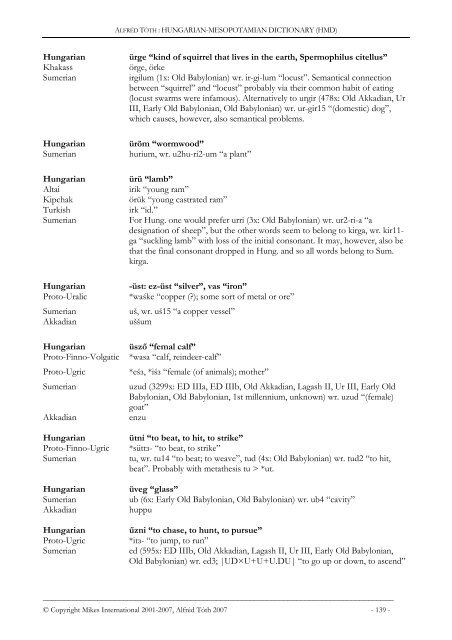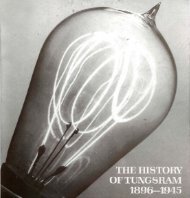Hungarian-Mesopotamian Dictionary (HMD)
Hungarian-Mesopotamian Dictionary (HMD)
Hungarian-Mesopotamian Dictionary (HMD)
Create successful ePaper yourself
Turn your PDF publications into a flip-book with our unique Google optimized e-Paper software.
ALFRÉD TÓTH : HUNGARIAN-MESOPOTAMIAN DICTIONARY (<strong>HMD</strong>)<br />
<strong>Hungarian</strong><br />
Khakass<br />
Sumerian<br />
<strong>Hungarian</strong><br />
Sumerian<br />
ürge “kind of squirrel that lives in the earth, Spermophilus citellus”<br />
örge, örke<br />
irgilum (1x: Old Babylonian) wr. ir-gi-lum “locust”. Semantical connection<br />
between “squirrel” and “locust” probably via their common habit of eating<br />
(locust swarms were infamous). Alternatively to urgir (478x: Old Akkadian, Ur<br />
III, Early Old Babylonian, Old Babylonian) wr. ur-gir15 “(domestic) dog”,<br />
which causes, however, also semantical problems.<br />
üröm “wormwood”<br />
hurium, wr. u2hu-ri2-um “a plant”<br />
<strong>Hungarian</strong> ürü “lamb”<br />
Altai<br />
irik “young ram”<br />
Kipchak<br />
örük “young castrated ram”<br />
Turkish<br />
irk “id.”<br />
Sumerian For Hung. one would prefer urri (3x: Old Babylonian) wr. ur2-ri-a “a<br />
designation of sheep”, but the other words seem to belong to kirga, wr. kir11-<br />
ga “suckling lamb” with loss of the initial consonant. It may, however, also be<br />
that the final consonant dropped in Hung. and so all words belong to Sum.<br />
kirga.<br />
<strong>Hungarian</strong><br />
Proto-Uralic<br />
Sumerian<br />
Akkadian<br />
<strong>Hungarian</strong><br />
Proto-Finno-Volgatic<br />
Proto-Ugric<br />
Sumerian<br />
Akkadian<br />
<strong>Hungarian</strong><br />
Proto-Finno-Ugric<br />
Sumerian<br />
<strong>Hungarian</strong><br />
Sumerian<br />
Akkadian<br />
<strong>Hungarian</strong><br />
Proto-Ugric<br />
Sumerian<br />
-üst: ez-üst “silver”, vas “iron”<br />
*waśke “copper (?); some sort of metal or ore”<br />
uš, wr. uš15 “a copper vessel”<br />
uššum<br />
üsző “femal calf”<br />
*wasa “calf, reindeer-calf”<br />
*eśз, *iśз “female (of animals); mother”<br />
uzud (3299x: ED IIIa, ED IIIb, Old Akkadian, Lagash II, Ur III, Early Old<br />
Babylonian, Old Babylonian, 1st millennium, unknown) wr. uzud “(female)<br />
goat”<br />
enzu<br />
ütni “to beat, to hit, to strike”<br />
*süttз- “to beat, to strike”<br />
tu, wr. tu14 “to beat; to weave”, tud (4x: Old Babylonian) wr. tud2 “to hit,<br />
beat”. Probably with metathesis tu > *ut.<br />
üveg “glass”<br />
ub (6x: Early Old Babylonian, Old Babylonian) wr. ub4 “cavity”<br />
huppu<br />
űzni “to chase, to hunt, to pursue”<br />
*itз- “to jump, to run”<br />
ed (595x: ED IIIb, Old Akkadian, Lagash II, Ur III, Early Old Babylonian,<br />
Old Babylonian) wr. ed3; |UD×U+U+U.DU| “to go up or down, to ascend”<br />
___________________________________________________________________________________<br />
© Copyright Mikes International 2001-2007, Alfréd Tóth 2007 - 139 -








![Letöltés egy fájlban [4.3 MB - PDF]](https://img.yumpu.com/50159926/1/180x260/letaltacs-egy-fajlban-43-mb-pdf.jpg?quality=85)








